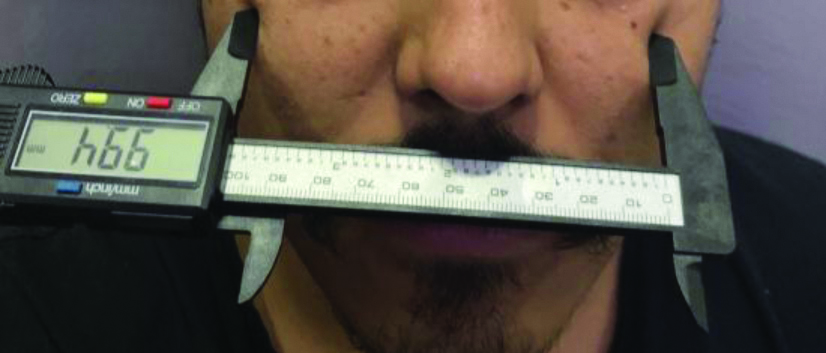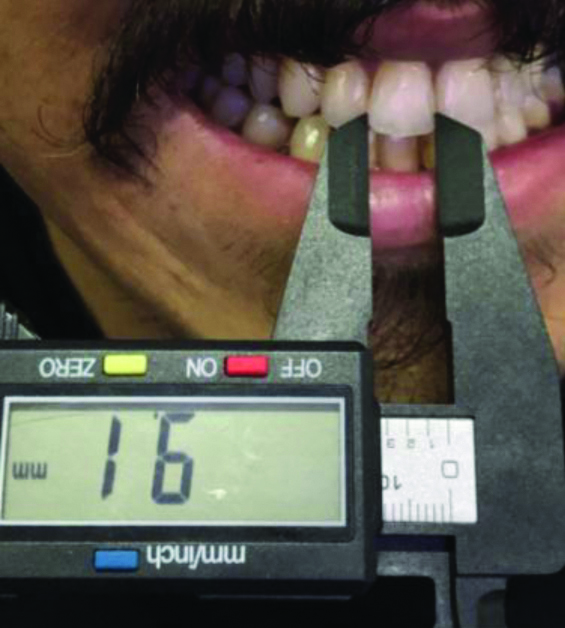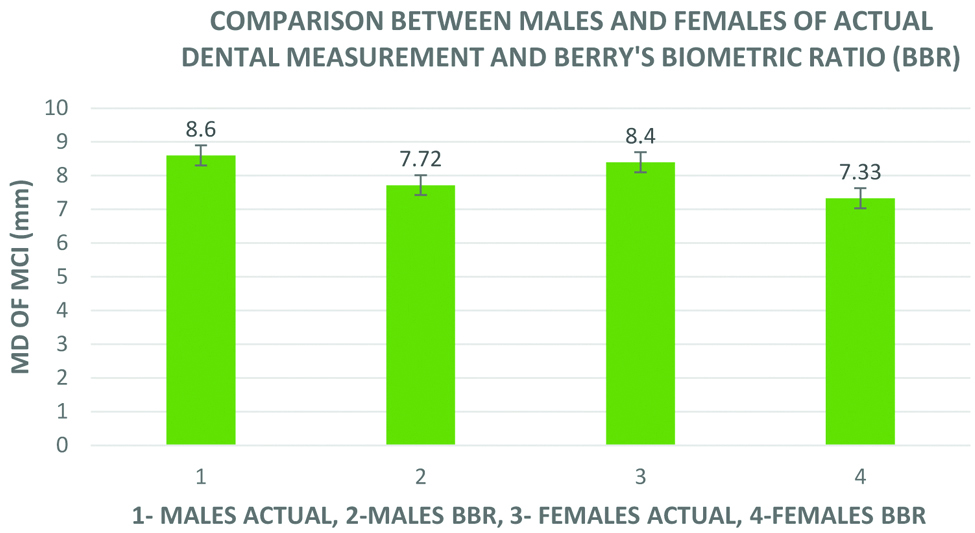Selection of teeth, when an edentulous patient comes for prosthetic rehabilitation, due to the absence of a natural guide, requires knowledge of some physical and biological factors that are directly related to each patient as an individual and thus becomes a challenge [1]. The width of the maxillary anterior teeth is more difficult to correlate with the facial measurements than the height of the maxillary anterior teeth [2]. Various parameters have been studied and used for determination of the size of the maxillary anterior teeth like interalar width, interpupillary distance, BZW, intercanthal distance, and intercommissural width [3-5]. Few studies have been done on newer anatomical measurements, such as pterygomaxillary notch, philtral width, the circumference of the skull, maxillary arch width, and maxillary arch length [2]. However, the chief limitation is that the soft tissue measurements are subject to variation and also there is a significant difference between the various facial parameters in distinct races and ethnic groups [2,5]. Therefore, the norms and features of one population cannot be used for another. Hence, little agreement has been reached on an effective method. There is no single anthropometric measurement that can quantify the MD of maxillary anterior teeth. Anthropometric measurements depend on the population group [2,6].
Berry introduced Berry’s biometric ratio method in 1906, stating that the MCI had a definite proportion to facial anatomy. The MD of MCI to the BZW ratio was 1:16 [6]. House and Loop found this ratio was between 1:13 and 1:19 [3,7]. Berry’s formula was applied to calculate the MD of the MCI based on the BZW.
Materials and Methods
This work was a cross-sectional study that was carried out in the outpatient dental clinics after getting the Institutional Ethical Committee permission (IEC Ref No. H-03-22122019) from Ibn Sina National College for Medical Studies, Jeddah, Saudi Arabia from December 2019 to March 2020. The sample (simple random sampling) was calculated according to earlier studies, which were of two hundred subjects, including a hundred males and females in the same number [1,10,14,15], which were selected according to the criteria below.
Inclusion criteria: Patients of Saudi descent (both mother and father), age between 18 and 40 years with well-aligned maxillary anterior teeth and healthy periodontium; have not undergone any endodontic treatment in the right MCI and no Prosthodontic treatment like crowns or fixed partial dentures in the anterior teeth and do not have any history of Orthodontic treatment in the subjects [1,2,10], were included in the study.
Exclusion criteria: Patients with any history of trauma to the teeth, maxillofacial surgery, or plastic surgery, those with gingival hyperplasia or gingival recession or missing permanent maxillary anterior and premolar teeth; those with any history of extraction or developmental anomalies of teeth; maxillary anterior teeth size alterations or cases of facial asymmetry and skeletal deformities [1,2,10] were excluded from the study.
All the participants were seated in an upright position on a dental chair with the head resting against the headrest and the occlusal plane parallel to the floor. For facial measurement, BZW was determined between two prominent ends on the zygomatic bone with the aid of a digital vernier caliper (Mitutoyo, UK Ltd.,) [Table/Fig-1]. In dental measurements, the MD of the right MCI [Table/Fig-2] was determined between interproximal contact points with a digital vernier caliper (with 0.01 mm accuracy). Quantification of proportions of BZW and MD of MCI were conducted in triplicate in arbitrarily chosen two hundred samples as stated above no less than two weeks from the primary calculation. The same four investigators (2 males and 2 females) did all measurements following the standardisation protocol. The intra-examiner reliability was assessed using the Kappa coefficient, which was 0.90, which reflects ‘excellent agreement.’ A single investigator did the BZW measurements for all male patients, and the second investigator recorded them and similar scenario was followed for female patients. The data were collected after consent from the patient in a prescribed format.
Measurement of Bizygomatic Width using digital vernier caliper.

Measurement of Mesiodistal Dimension of Maxillary Right Central Incisor using digital vernier caliper.

Statistical Analysis
The measurements were compiled and entered in Microsoft Excel 2015, computer program, and then exported to the data editor page of Statistical Package for the Social Sciences version 24.0 (SPSS Inc., Chicago, IL, USA). Descriptive statistics were carried out, a student’s t-test was done with a level of significance at 5% (0.05), and the power of the study was 95%. Student’s t-test was used to compare all measurements between males and females. p<0.05 was considered statistically significant. Pearson’s correlation coefficient (r) was used to know the relationship between BZW and MD of MCI by linear correlation coefficient analysis.
Results
The mean age of female subjects was 27.3 years, ranging from 18 to 40 years, and male subjects were 25.7 years, ranging from 21 to 40 years. The average value for BZW for males was 123.56±3.74 mm and ranged 115.1 to 132.6 mm. The same parameter was 117.33±3.21 mm in females and ranged from 102.7 to 123.6 mm. The results of the same are summarised in [Table/Fig-3].
Comparison between the bizygomatic width of males and females.
| Statistics | BZW (mm) | ‘t’ value | p-value |
|---|
| Males±SD | Females±SD |
|---|
| Mean | 123.56±3.74 | 117.33±3.21 | 12.63 | <0.001* |
| Range | 115.1-132.6 | 102.7-123.6 |
(*Student t-test- p<0.05=significant); p-value <0.001 to be highly significant
The average value for MD of MCI for males was 8.6±0.46 mm, and the value ranged from 7.7 to 9.4 mm, whereas the average value of MD of MCI in females was 8.4±0.53 mm and the value ranged from 7.0 to 9.4 mm. The results of the same are highlighted in [Table/Fig-4].
Comparison between the Mesiodistal Dimension (MD) of Maxillary Central Incisor (MCI) of males and females.
| Statistics | MD of MCI (mm) | ‘t’ value | p-value |
|---|
| Males±SD | Females±SD |
|---|
| Mean | 8.6±0.46 | 8.4±0.53 | 2.87 | 0.002* |
| Range | 7.7-9.4 | 7.0-9.4 |
(*Student t-test- p<0.05=significant)
[Table/Fig-5] shows the value of the ratio of MD of MCI and BZW for males and females was 0.07±0.004 and 0.072±0.004, respectively.
Comparison between the Mesiodistal Dimension (MD) of Maxillary Central Incisor (MCI) to Bizygomatic Width (BZW) ratio of males and females.
| Subjects | Age in years | MD of MCI/BZW | MD of MCI to BZW ratio | ‘t’ value | p-value |
|---|
| Average | Range |
|---|
| Males | 25.7 | 21-40 | 0.07±0.004 | 1:14 | 1.65 | 0.001* |
| Females | 27.3 | 18-40 | 0.072±0.004 | 1:14 |
(*Student t-test- p<0.05=significant)
[Table/Fig-6] shows Pearson’s correlation coefficient (r) between facial and dental measurements and was found to be positive in the range of 0.067 for males and 0.007 for females.
Pearson’s correlation coefficient (r) between facial and dental measurements of males and females.
| Subjects | Variables studied | Mean (mm) | Number | Pearson’s correlation coefficient (r) |
|---|
| Males | Facial measurement | 123.56±3.74 | 100 | 0.067 |
| Dental measurement | 8.6±0.46 | 100 |
| Females | Facial measurement | 117.33±3.21 | 100 | 0.007 |
| Dental measurement | 8.4±0.53 | 100 |
[Table/Fig-7] shows the actual measurement of MD of MCI of males and females was 8.6 mm and 8.4 mm, respectively. When Berry’s formula was applied, it was 7.72 mm, for males and 7.33 mm for females.
Comparison between males and females of actual dental measurement and Berry’s Biometric Ratio (BBR).

Discussion
It is established that facial features vary with distinct races and ethnic origins. Different anthropometric landmarks have been recommended for complementing anterior teeth selection in the absence of pre-extraction records [5,15-18]. Previously, extracted teeth were the sole medium used to measure racial, ethnic, and gender differences in teeth measurement. In most studies, clinicians used casts to measure tooth dimensions for intraoral estimations [10]. Some reports emphasise the role of MD of MCI in gender identification [19]. This study was conducted on the Saudi population to identify the aesthetic relationship between facial and dental features. The proportion of the MD of MCI to BZW and was calculated to contrast its measurements with the earlier aesthetic guidelines and results. BZW is considered the widest point on the face and is constant through life, helps in measuring the facial skeletal breadth of a specific individual if an anomaly in the teeth or dental arch develops [10]. [Table/Fig-8] shows various studies [1,3,10,14,16,20] on BZW and compared them with the present study.
Comparison of various studies on Bizygomatic Width (BZW) [1,3,10,14,16,20].
| Author (year) | Ethnicity | Males | Females |
|---|
| Rawat A et al., [1] (2015) | Indian | 119.76±0.47 mm | 118.43±0.46 mm |
| Parciak EC et al., [3] (2017) | African American | 178.9±14.54 mm | 167.3±10.77 mm |
| White | 175.0±10.65 mm | 166.4±10.63 mm |
| Asian | 180.4±12.15 mm | 168.7±10.43 mm |
| Algarni AM et al., [10] (2019) | Saudi | 113.9±3.2 mm | 121.3±7.79 mm |
| Sayed ME et al., [14] (2017) | Saudi | 111.2±10.32 mm | 131.5±8.80 mm |
| Radia S et al., [16] (2016) | White British | 137.94 mm | 130.51 mm |
| Nagle E et al., [20] (2005) | Latvian | 13.31 cm | 12.24 cm |
| The present study (2020) | Saudi | 123.56±3.74 mm | 117.33±3.21 mm |
As is seen in [Table/Fig-8], only Algarni AM et al., and Sayed ME et al., reported that Saudi females have wider BZW than Saudi males, which they attribute to denser soft tissues on the face, but in all other studies, the BZW of males was more than females, similar to the present study [10,14].
Men exhibit wider anterior teeth than women do, as the gender variations in the dimensions of the anterior teeth have been noted for most racial groups, and also men also have wider bony structures [10]. The MD of MCI measurements by various authors [1,3,10,14,21,22] is summarised in [Table/Fig-9] and compared with the present study. The present study findings for MD of MCI are the same as those of earlier studies, where males have wider MD of MCI than females.
A comparison of various studies on Mesiodistal Dimension (MD) of Maxillary Central Incisor (MCI) [1,3,10,14,21,22].
| Author (year) | Ethnicity | Males | Females |
|---|
| Rawat A et al., [1] (2015) | Indian | 8.51±0.24 mm | 8.29±0.16 mm |
| Parciak EC et al., [3] (2017) | Asian | 8.2±0.51 mm | 7.8±0.46 mm |
| African American | 8.5±0.57 mm | 7.9±0.50 mm |
| White | 8.1±0.46 mm | 7.7±0.44 mm |
| Algarni AM et al., [10] (2019) | Saudi | 8.6±0.21 mm | 8.47±0.53 mm |
| Sayed ME et al., [14] (2017) | Saudi | 8.7±0.59 mm | 8.56±0.47 mm |
| Sterrett JD et al., [21] (1999) | Caucasian | 8.59 mm | 8.06 mm |
| Song JW et al., [22] (2017) | Korean | 8.54 mm (did not specify gender) |
| The present study (2020) | Saudi | 8.6±0.46 mm | 8.4±0.53 mm |
The relationship between the MD of MCI and BZW (1:16) is commonly utilised to determine the size of the anterior maxillary teeth [3,14,23,24]. The MD of MCI/BZW was found to be 0.07±0.004 for males, whereas it was 0.072±0.004 for females and was statistically significant which is similar to the study by Rawat A et al., and that by Algarni AM et al., for Saudi females [1,10]. In this study, the ratio of MD of MCI to BZW was found to be 1:14 for males and females were in the same range of ratios between 1:13 and 1:19 which was found by House and Loop [3,7]. A study by various authors [1,3,10,14] and its comparison with the present study is shown in [Table/Fig-10]. In the studies of Hasanreisoglu U et al., took full-face pictures and dental casts from 100 subjects, and their results showed a 16:1 ratio in women [25]. Their method of landmark determination was not clarified. They found this ratio only in women. However, Kern BE disputed this in 1967 in a study to analyse the relationship between the skull and tooth size. His study results showed that 92 (18%) to have an MD of MCI to BZW ratio of 14:1, 216 (42%) a ratio of 15:1, 157 (31%) a ratio of 16:1, and 42 (8%) a ratio of 17:1 and concluded that the correlation between the MD of MCI to BZW was inconsistent [26].
Comparison of various studies on the ratio of Mesiodistal Dimension (MD) of Maxillary Central Incisor (MCI) to Bizygomatic Width (BZW) [1,3,10,14].
| Author (year) | Ethnicity | Males (MD of MCI/BZW) | Males (MD of MCI to BZW ratio) | Females (MD of MCI/BZW) | Females (MD of MCI to BZW ratio) |
|---|
| Rawat A et al., [1] (2015) | Indian | 0.071 mm | 1:14 | 0.069 mm | 1:14 |
| Parciak EC et al., [3] (2017) | Asian | 0.049 mm | 1:20 | 0.050 mm | 1:20 |
| African American | 0.052 mm | 1:19 | 0.054 mm | 1:18 |
| White | 0.051 mm | 1:20 | 0.051 mm | 1:19 |
| Algarni AM et al., [10] (2019) | Saudi | 0.075 mm | 1:13 | 0.069 mm | 1:14 |
| Sayed ME et al., [14] (2017) | Saudi | 0.078 mm | 1:13 | 0.065 mm | 1:15 |
| The present study (2020) | Saudi | 0.070 mm | 1:14 | 0.072 mm | 1:14 |
The actual measurement in the present study of MD of MCI of males was 8.6 mm but when Berry’s formula was applied i.e. Berry’s formula: MD of MCI=BZW/16, it was 7.72 mm and the actual measurement of MD of MCI of females was 8.4 mm but when Berry’s formula was applied it was 7.33 mm. Therefore, Berry’s formula did not apply to this study, which is like the study by Rawat A et al., where the males have 7.38 mm and female 7.39 mm [1].
As first reported about 100 years ago, when selecting denture tooth molds, Berry’s ‘biometric ratio’ of 1:16 (MD of MCI to BZW) was the basis for the Trubyte Tooth Selector Instrument that still finds its valued position in some texts. It is clear from the present study that BZW cannot be the sole method to select the anterior teeth. Hence, this method of selecting teeth for the Saudi population may not be suitable. Over the years, the MD of MCI has been compared with a host of other anthropological measurements [27], which should be used holistically to arrive at a consensus to select the anterior teeth.
The findings of this study showed that there was a weak positive correlation between the MD of MCI and the BZW (r=.067 for males and .007 for females). These findings are like the study by Rawat A et al., where r=.007 for males and .03 for females, but Algarni AM et al., found a weak negative correlation (-.053) between the MD of MCI and BZW [1,10].
The query remains the same as which method can be generalised to all populations so that selection of teeth becomes simpler for edentulous patients. The most recent literature has shown so many diverse extraoral and intraoral techniques for calculation of either the dimensions of all maxillary anterior teeth or individual tooth dimensions [2,5,10,14,15]. Many factors might have affected the correctness of formerly published data [14]. These factors include the materials used, determination of landmarks, type and precision of the instrument used for measuring specific dimensions, cast measurement, a photographic study, or whether the measurement was done on a straight line or in a curve [14]. In this study, efforts were made to standardise the measurements even though the sample size of the study tested was small, but still, differences cannot be negated. Literature shows much less published data on the Saudi Arabian population where the prediction of anterior teeth dimensions was done [9-14]. Prospective studies are needed to establish a common national or global database to assist in individual, gender, race, and ethnic identification, which could provide rules that will help clinicians and laboratory technicians in Saudi Arabia in selecting anterior teeth size for their patients. This aim is beyond this study and should be planned for prospective studies.
Limitation(s)
Firstly, the present study only relied on BZW as an indicator for measuring the facial parameters. The study could have been done on different facial measurements and comparisons could be made between identical parameters among the various studies from different countries. Secondly, the sample being homogeneous, the biometric ratio derived is more applicable to the population tested. Besides, this study could have been extended to an even larger population (i.e., more than 1000) for far better and accurate results. This study was conducted in Jeddah City, and results might vary if the same study was performed across different cities of Saudi Arabia. Lastly, as Saudi Arabia hosts many expatriate populations, the present study, could have included cases of different ethnicities and compared with the Saudi population.
Conclusion(s)
According to Berry’s formula: MD of MCI=BZW/16, which is considered being ideal, cannot be applied to the Saudi population, although the selected population size was small. Besides, the facial width, which was calculated according to BZW, must not be a sole aid in selecting maxillary anterior teeth. For dental rehabilitation of the Saudi Arabian population, a larger sample size covering the entire sample population of Saudi Arabia and involving more anthropometric measurements must be planned to frame more definite guidelines for the selection of maxillary anterior teeth.
(*Student t-test- p<0.05=significant); p-value <0.001 to be highly significant
(*Student t-test- p<0.05=significant)
(*Student t-test- p<0.05=significant)